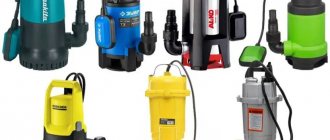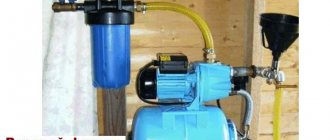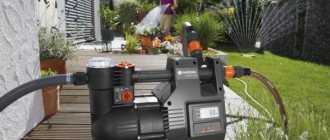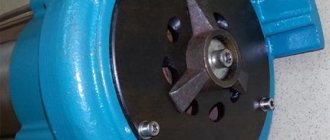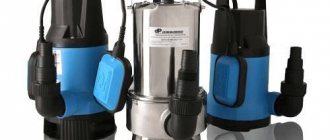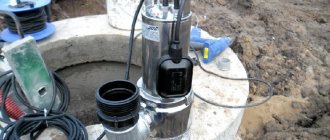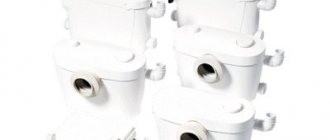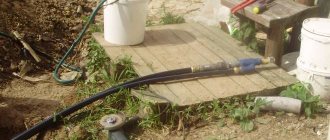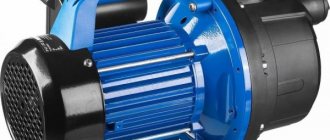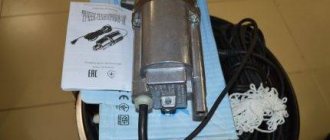By type of operation, pumps are divided into:
- self-priming or centrifugal. The incoming liquid is scattered onto the walls from the rotating blades. Such pumps operate with little noise and are quite heavy;
- Vortex pumps - the blades in the rotation wheel have a non-standard size, due to which a vortex flow is created. The fluid pressure is five times higher than centrifugal ones. Overall dimensions are significantly smaller. However, their operation requires compliance with special conditions.
Classification of pumping equipment
For use in a summer cottage or individual building, centrifugal devices are most widely used. They are capable of moving liquids with minor contaminants. According to the principle of operation, they have a submersible drainage system.
To perform the work, the devices must be placed at the bottom of the container to be cleaned. This could be a well or a swimming pool. The liquid mass is pumped out through a mesh specially installed at the bottom of the pump. Thanks to the small mesh cells, the water flow is filtered.
The use of drainage equipment is not recommended for pumping out cesspools and fecal tanks. They should be used to clean swimming pools, wells, and basements.
Submersible drainage equipment is installed at the bottom of the tank. The water flow is moved using a special hose attached to the pump. The device has a hole with a grill to prevent clogging from foreign objects.
By type of application, pumps are divided into:
- well pumps;
- fecal equipment;
- drainage devices;
- pumps for wells.
Surface pumps consist of a hose that is immersed in a liquid and flow is removed through it. According to their purpose, they are divided into pressure equipment, pumping stations, circulation equipment and garden universal spectrum equipment.
Connection rules
Electrical installation work, installation and adjustment of automation, grounding equipment and connection to the central power supply network must be entrusted to an electrician. Mechanical equipment can be assembled independently in strict compliance with safety regulations when working with electrical installations.
According to this document:
- Operation of the mechanism without grounding is not allowed.
- The device must be equipped with a residual current device.
- Repairing and servicing the equipment while the power is connected is strictly prohibited.
- The presence of air in the intake line is not allowed.
- Operating the station without water (“dry”) is prohibited.
- The temperature of the incoming liquid is +1…+50°С.
- the optimal suction depth is 9-10 m.
- The diameter of the intake line must be larger than the nominal bore of the inlet fitting.
- When laying the supply pipeline, it is necessary to ensure a constant angle of inclination of the axis of the water pipeline to the horizon level of at least 1°.
To connect the transfer pump, you need to perform a number of the following technical procedures:
- Install a check valve or foot valve on the intake pipe.
- Connect the water line to the inlet pipe located at the end of the mechanism body.
- Connect the pressure line to the supply fitting on the top of the device.
- Make sure the system is tight.
- Fill the suction pipe and the working chamber of the pump with water through the plug located on the top cover of the device.
- Using a pressure switch (if available), configure the parameters for automatically turning off and turning on the pump.
- Check the presence of 220 V voltage in the network (or another according to the passport).
- Start the pumping station.
If the mechanism is inactive for a long time in winter, the equipment must be stored and maintained in a heated, dry room.
Comparative characteristics of pumps
Various surface pumps are used for a variety of application conditions. To lift water from wells or supply it from a deep reservoir, it is recommended to purchase a submersible device. In case of infrequent drainage of dirty water from basements or for watering the lawn, self-priming surface equipment can be used. It has less power compared to submersible.
For domestic use, such a pump has positive characteristics.
- the simple design is easy to maintain even for beginners;
- deep liquid supply is possible up to 10 meters;
- has two functions - supplying water flow and pumping out liquid;
- mobile and lightweight design. When necessary, it can be easily transferred to another place for further work.
In the household it is possible to use stationary equipment. For its installation it is necessary to arrange a special site. The priority of this choice is the need for a constant supply of water with good pressure.
It is also important to know about the features of long-term equipment service. When using a surface device in winter to prevent freezing, the pump must be kept in a warm room.
Operating rules
Despite the versatility of all pumps of this type, you should inquire in advance about the possibility of using them to transport clean water. It may seem that a pump capable of pumping dirty liquid can also handle clean liquid, but in most cases the design features of the machines do not allow this possibility (for example, due to the inlet opening being too wide).
Surface pump for pumping out dirty water Aiken
There are other rules, the observance of which will ensure the durability and trouble-free operation of the surface pump:
- Models of any type should not be immersed in water.
- The connection to the power source should be made through a safety circuit breaker, which will prevent failure of the pumping unit during voltage surges.
- It is imperative to comply with the operating conditions of the pump regarding the composition of the liquid (percentage of impurities, their maximum permissible size, chemical aggressiveness of the environment, liquid temperature, abrasiveness of inclusions).
- Do not transport (including move, tilt, pump) a running pump.
- When using the pump year-round, it is important to take care of thermal insulation and heating of the system to avoid freezing.
If you need to choose a water pump for a well to supply clean water, we recommend reading our separate article.
We talked about hand pumps for water in this material. You will learn what they are and how to choose the appropriate option.
How the pumping station is connected to the well is described on this page https://okanalizacii.ru/vodosnabzhenie/nasosy-i-stancii/podklyuchenie-nasosnoj-stancii-k-skvazhine.html
Operating principle of a surface pump
Centrifugal devices should be filled with water during the first run. Manufacturers guarantee long-lasting service to modern equipment. The pumps are equipped with a device that protects the reverse action of water flow. It is built into the suction funnel and creates a repeated self-priming action the next time the equipment is turned on, even if the suction hose is partially filled with liquid or the suction hose is empty.
Centrifugal pumps duplicate the functional capabilities of drainage devices. Protective filters are capable of stopping particles with a fraction of up to 15 millimeters. In addition to domestic use, their use is possible on construction sites, when irrigating land, to reduce groundwater levels.
The developers have supplemented self-priming devices with multi-stage impellers to increase productivity while maintaining sufficient power and moderate energy consumption.
Modern centrifugal pumps are capable of pumping out water masses from depths of up to 9.5 meters. In addition, they are equipped with increased noise insulation and are complemented by a protective mechanism against accidental switching on of empty equipment.
All pump modifications should be installed on a specially equipped platform, which should be located above a container with liquid. Using an inlet pipe or hose that goes down to the very bottom of the tank, the water flow is pumped continuously. The power of the centrifugal pump allows you to lift water masses from a depth of up to nine meters. Increasing power is possible using a special built-in ejector.
Mobile pumping equipment is designed similarly to stationary stations. If necessary, it can maintain a constant water pressure.
Well cross section and pressure
When creating a well, pipes of a certain cross-section are used. Taking into account their diameter, it is necessary to select pumping equipment. If the owner will submerge the installation to supply water, then in this case its size should be slightly smaller than the cross-section of the wells. Currently, the most common cross-section of casing pipes is 4 inches, which in terms of the more familiar measurement system is equal to 100 mm. Therefore, when choosing a pump, it is necessary to focus on this size.
Before purchasing a device, it would be a good idea to consult with specialists who will be drilling wells. They can give you recommendations on which well pump is best for your shallow well. You should also know which models are best for sand wells. If you do not take this point into account when purchasing pumping equipment, then during operation it can quickly fail due to the strong influence of sand fractions on its operation.
For example, if the owner decides to use the most popular model of the “Rucheek” pump, then he will be able to ensure efficient water supply in a well up to 15 meters deep. With its help, you can organize a stable water supply in your area at low cost.
When choosing a pump, you should pay attention to the maximum pressure it can support. To do this, you need to refer to the technical documentation. The value of this parameter in the passport for the pump is indicated in bars. The most important parameter is the suction depth. To determine the maximum pressure, it is necessary to use the suction depth characteristic. To this value you need to add 30, and for greater reliability add an additional 10%. If the well has a total depth of 15 meters, then to ensure water intake using a pump, a device is needed that provides a pressure of 50 bar.
Equipment selection
To accurately select a device, you need to know exactly what functionality it will perform, the degree of contamination and the volume of pumped liquid masses.
If used for pumping clean water, it is recommended to purchase vortex equipment. But it should not be used for pumping water of any degree of contamination. Therefore, the most important factor of choice is the degree and amount of contaminants in the liquid mass. In addition, the frequency of use of the equipment should be established.
In small garden plots, manufacturers recommend the use of surface drainage equipment. He can easily cope with clearing the basement from seasonal flooding of melt water. Simplicity of execution and convenient maintenance will be possible even for older people. Low power and low productivity will not be an obstacle for small jobs.
In case of typical contamination in the form of leaves or paper waste, you should opt for submersible or fecal pumps. A wide range of products and various technical characteristics allow you to select equipment with the necessary functionality for specific work. Manufacturers produce products with different power ratings, which makes it possible to pump out wastewater with different viscosities.
Popular models
- Pedrollo D20. Powerful drainage pump. Capacity 20 m3/h. Head 27 m. Lifting height 5 m.
- Pedrollo NGA. Centrifugal. Capacity 21m3/h. Head 19.5m. Lifting height 7 m.
- Grunfos Unilift CC 9 A 1. Universal. Capacity 14 m3/h. Lifting height 9m.
- Grunfos Unilift CC 5 A 1. Budget pump. Capacity 6 m3/h. Lifting height 5m.
- Calpeda A 40 – 11- A/A. Centrifugal self-priming. Capacity 10.8 m3/h. Head 11.8 m.
- 1 Dwarf 6-10. Drainage pump. Capacity 6m3/h. Head 10m.
- Gardena 3500/4 Classic. Pumps dirty and clean water. Capacity 3.6 m3/h. Lifting height 7m. head 41m.
Using hydraulic tanks
This is a tank assembled from sheet metal and divided into 2 compartments by an elastic membrane. The partition is made of 2 varieties - a cylinder and a diaphragm, the second is installed in the middle of the tank, a pear-shaped membrane is attached to the inlet.
According to their intended purpose, there are 3 varieties, for:
- Heating systems;
- Hot water;
- cold water.
Externally, they differ in color: red for heating systems, blue for cold water. Hydraulic accumulators can be installed vertically or horizontally. Vertical ones have special supports, some products are equipped with plates for mounting on the wall.
Externally, they are elongated upward, they are often used to organize water supply in private households - they require less space for installation. Horizontal devices are more often used for pumping stations; a surface pump is mounted on top of them; the entire installation takes up very little space.
Overview of high power units
Gilex Jumbo 70/50 P-50
The equipment takes water from a depth of 9 m, and the supply distance is 50 m.
Grundfos IP Basic 3 PT
The fence is 8 m deep, the supply is 47 m.
Gardena 500/5 Comfort
The device can extract water from a depth of 8 m, and the supply is carried out at 45 m.
Such pumping stations have a high level of power due to their high-quality design.
Advantages:
- High level of performance
- Ability to provide water to a large area or structure
- Protection devices included
Expert opinion
Kuznetsov Vasily Stepanovich
Among the disadvantages of such devices, it is worth noting the high level of energy consumption and high requirements for their installation and maintenance.
Hydraulic accumulator pumps
Such a device should be selected taking into account the function of regulating pressure, starting and stopping the pump, and it is also necessary to check the water supply capabilities and the suitability of the selected equipment.
A good model of this type is considered to be Jumbo 60/35. The unit is equipped with a container made of cast iron and steel.
Features of the system:
- Ensuring stable pressure
- Sudden pressure surges during pumping, associated with hydraulic vibrations
- Frequent system startup
To prevent sudden changes, such a station is equipped with a hydraulic accumulator.
How to connect
These installations are always located in a dry place - it is not permissible for moisture to get into the housing. Ideally, it should be installed as close to the water supply as possible. You need to choose a dry room with a positive temperature, which should be well ventilated. It is permissible to place the pumping station in the basement, but with such an installation you will have to constantly endure a little noise.
Near the well or well, in the place where the surface vortex pump or the installation of another system will be located, small buildings are erected or installed in underground caissons - welded from metal, plastic, poured from concrete mortar.
The caissons must also be ventilated; their bottom is lowered below the soil freezing level. The water supply pipes are laid to the house by deepening it into a trench, also lowering it into non-freezing layers of soil.

